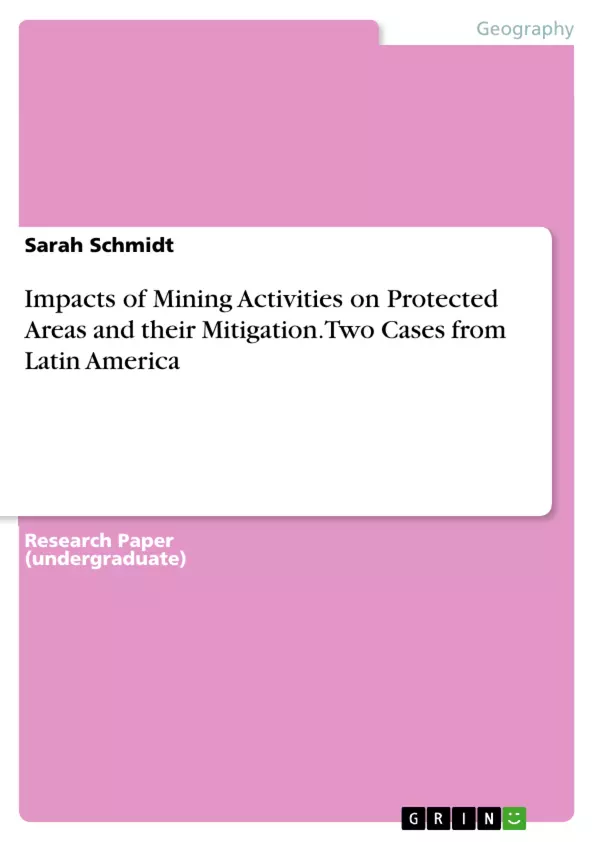Latin America is rich in vulnerable biodiversity of flora and fauna, outstanding landscapes and ecosystems and natural resources. Protected areas (PAs) are a tool for the conservation of land cover and ecosystem services. But the world demand for natural resources is rising and with it resource extraction and intensive land use.
Metal mining activities are one of the biggest threats towards PAs and these activities are steadily increasing. Deep environmental and social conflicts are associated with mining activities worldwide and especially in Latin America.
The research question of this paper is: What are potential social and environmental impacts of mining activities on PAs and how can they be mitigated?
The aim of the paper is to figure out important impacts of mining activities on PAs and to highlight possible solutions for mitigation.
Inhaltsverzeichnis (Table of Contents)
- 1. Introduction
- 2. Mining - An Overview
- 2. 1 Phases and Forms of mining and interconnected environmental impacts
- 2. 2 Environmental and social conflicts in connection with mining and the relevance for protected areas (PAs)
- 2. 3 General solutions and regulations for mitigation
- 2. 4 Current state of research
- 3. Case Studies
- 3.1 The case of the Intag cloud forest region in Ecuador
- 3.1.1 Overview of the Intag cloud forest region
- 3.1.2 Mining activities within the Intag region and related environmental and social impacts
- 3.1.3 Means of mitigation
- 3.2 The case of the Huascarán National Park in Peru
- 3.2.1 Overview of the Huascarán National Park
- 3.2.2 Mining activities within the Huascarán National Park and related environmental and social impacts
- 3.2.3 Means of mitigation
- 4. Resume and Conclusion
Zielsetzung und Themenschwerpunkte (Objectives and Key Themes)
This paper aims to investigate the potential social and environmental impacts of mining activities on protected areas (PAs) and explore possible mitigation strategies. It specifically focuses on the case studies of the Intag cloud forest region in Ecuador and the Huascarán National Park in Peru. Key themes and objectives include:- Examining the phases and forms of mining and their associated environmental impacts.
- Analyzing the environmental and social conflicts arising from mining activities, particularly in relation to PAs.
- Identifying general solutions and regulations for mitigating these impacts.
- Presenting the current state of research on mining impacts and mitigation strategies.
- Providing practical insights from the case studies of Intag and Huascarán.
Zusammenfassung der Kapitel (Chapter Summaries)
Chapter 1: Introduction
This chapter introduces the topic of mining impacts on protected areas in Latin America, highlighting the region's rich biodiversity and the increasing threat posed by mining activities. It outlines the research question, the aim of the paper, and the structure of the subsequent chapters.Chapter 2: Mining - An Overview
This chapter provides a comprehensive overview of mining practices, including the different phases of a mining project, various forms of mining, and their associated environmental impacts. It delves into the environmental and social conflicts arising from mining activities, particularly in relation to protected areas. The chapter also explores general solutions and regulations for mitigating these impacts and examines the current state of research on this topic.Chapter 3: Case Studies
This chapter presents two case studies from Latin America: the Intag cloud forest region in Ecuador and the Huascarán National Park in Peru. It examines the specific mining activities in these areas, the related environmental and social impacts, and the mitigation measures implemented.Schlüsselwörter (Keywords)
This paper explores the environmental and social impacts of mining activities on protected areas, particularly in Latin America. Key keywords include: mining, protected areas, biodiversity conservation, environmental impacts, social conflicts, mitigation strategies, case studies, Intag cloud forest region, Huascarán National Park, Ecuador, Peru.- Quote paper
- Sarah Schmidt (Author), 2015, Impacts of Mining Activities on Protected Areas and their Mitigation. Two Cases from Latin America, Munich, GRIN Verlag, https://www.grin.com/document/302514



